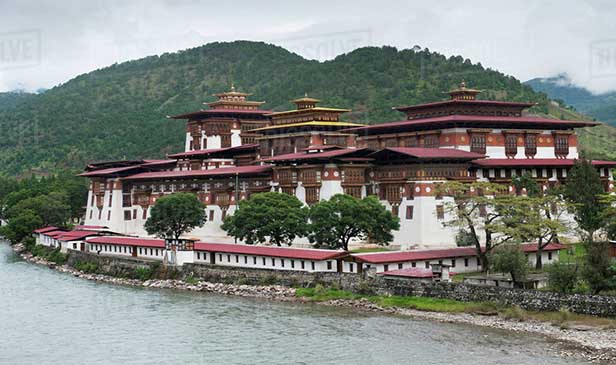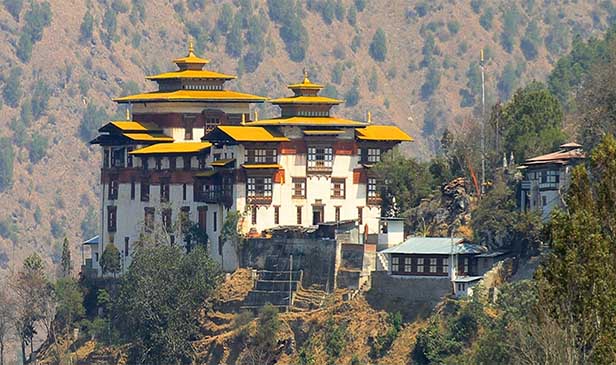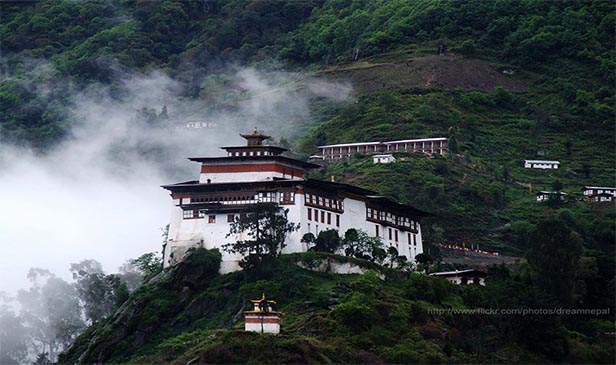Day 01: ARRIVE AT PARO- THIMPHU
Day 02: THIMPHU
Day 03: THIMPHU- PUNAKHA
Day 04: PUNAKHA- TRONGSA- BUMTHANG
Day 05: BUMTAHNG
Day 06: BUMTHANG- PHOBJIKHA
Day 07: PHOBJIKHA- PARO
Day 08: PARO- EXCURSION TO TAKTSANG
Day 09: DEPARTURE
Day 01: ARRIVE PARO (BY DRUKAIR FLIGHT)
On arrival, representative from Bhutan Sangay Tours will receive you at the airport and drive you the short distance to the hotel. After Lunch, visit Ta Dzong (built in 1656 and renovated in 1968), an ancient watchtower, which now houses the National Museum. Below the museum is the Paro Rimpung Dzong (literally meaning ‘Heap of Jewels’), built in 1646 by Zhabdrung Ngawang Namgyal, the centre of civil and religious authority in this valley. A short walk takes you to the base of the dzong and across a traditional cantilevered, covered bridged where you will be waiting to be driven to Thimphu. Overnight in Hotel.
Day 02: THIMPHU
The day begins with a visit to the National Memorial Chorten built in 1974 to honor of our late King Jigme Dorji Wangchuk and Changangkha Lhakhang, the Dupthop Lhakhang one of the few surviving nunneries in Bhutan. We then visit the National Library, stocked with ancient Buddhist manuscripts, and the Painting School where traditional art is still kept alive through instructions in the art of painting Thangkas (sacred Buddhist religious scrolls). After lunch we drive to the Traditional Medicine Institute where medicines are prepared according to ancient practices. Visit Bhutanese paper factory at work. Other highlights include a visit to the Tashichhoe Dzong, seat of the national government and the Central Monastic Body, including the summer residence of the Je Khenpo (Chief Abbot of Bhutan). Finally visit the Handicrafts Emporium followed by shopping for souvenirs in the shops of Thimphu. Overnight in the Hotel.
Day 03: THIMPHU – PUNAKHA
After breakfast, Drive to Punakha via Dochula pass. If the weather is clear, we stop for a while at Dochula pass to view Higher Himalayas. On the way, visit Chime Lhakhang, which was built by Lama Drukpa Kuenley. He subdued the demons with his ‘Magical Thunder bolt’. The Temple is also known as ‘the Temple of Fertility’. Visit Punakha Dzong built in 1637 by Zhabdrung Ngawang Namgyal and is situated between Pho Chu (Male river) and Mo Chu (Female river). The Dzong was named Druk Pungthang Dewachen Phodrang (Palace of Great Happiness). For many years until the time of the second king, it served as the seat of the Government. Punakha is still the winter residence of Je-Khenpo and King Jigme Dorji Wangchuk convened the new national Assembly here in 1952.Overnight in Hotel.
Day 04: PUNAKHA –TRONGSA- BUMTHANG
We start early today. After breakfast drive to Bumthang via Trongsa. Drive further up until the Pelela pass at 3300m which separates the west from the central. You will descend down until you reach Trongsa. Visit Trongsa Dzong, the most impressive dzong in Bhutan, built in its present form in 1644 by Chogyal Minjur Tempa, the official who was sent by Zhabdrung to unify eastern Bhutan and was enlarged at the end of the 17th century by Desi Tenzin Rabgay. Trongsa Dzong is the ancestral home of the present Royal Family and first two hereditary kings ruled Bhutan from this Dzong. Resume your drive further to Bumthang. Overnight in the hotel.
Day 05: BUMTHANG
After breakfast, visit Jakar Dzong, which literally means ‘The Castle of White Bird’. The current structure was built in 1667 and is said to be the largest Dzong in Bhutan and visit Jambay Lhakhang said to have been built by King Tsongsen Gampo of Tibet in the year 659 AD on the same day as Kyichu Lhakhang in Paro. The temple was visited by Guru Rimpoche during his visit to Bumthang and was renovated by Sindhu Raja after Guru Rimpoche restored his life force. Under the temple is said to be a lake in which Guru Rimpoche hid several Terma. In October one of the most spectacular festival, ‘Jambay Lhakhang Drup’ is staged here. Then visit Kurjey Lhakhang that is named after body print of Guru Rimpoche, built in 1652 by Minjur Tempa. Visit Tamshing Lhakhang (Temple of the good message), established in 1501 by Pema Lingpa and is the most important Nyingmapa temple in the kingdom. Overnight in the hotel
Day 06: BUMTHANG- PHOBJIKHA
Early breakfast, drive to Phobjikha the glacier valley which is the winter home of the endangered bird Black Necked Crane. En-route visit Ta Dzong ‘tower of Trongsa’ an ancient watch tower. The chapel inside the Ta Dzong is said to be dedicated to the Trongsa Penlop Jigme Namgyal which now have been transformed in the museum. Once in Phobjikha visit Gangtey Goemba Monastery, which was founded by Gyalse Pema Thinley, the grandson and mind reincarnation of Pema Lingpa founded the Temple in 1613. It is a Nyingmapa monastery and is affiliated to other Nyingmapa monasteries including Tamshing in Bumthang. Explore Phobjikha valley, which is famous for the Black Necked Cranes during winter. Overnight in the hotel.
Day 07: PHOBJIKHA-PARO
After breakfast we will drive for Paro. En-route visit Wangdiphodrang Dzong built in 1639. The Dzong is situated at the confluence of Punatsangchu and Dang Chu rivers. And further to the Dochula pass. If you have not seen the snowcapped mountains on the way to Punakha, this is another chance to see if you have the clear weather. Overnight in the hotel in Paro.
Day 08: PARO- EXCURSION TO TAKTSANG
A very special day, with an excursion to view the spectacular Taktsang (Tiger’s Nest) monastery – After breakfast a short drive takes us to ramthangka, from here a 2 hour hike till the viewpoint point of the monastery. The trail climbs through beautiful pine forest, many of the trees festooned with Spanish moss, and an occasional grove of fluttering prayer flags. We stop for a rest and light refreshments at the Taktsang Jakhang (cafeteria) and then walk a short distance until we see, clearly and seemingly within reach, Taktsang monastery. The primary Lhakhang was built around Guru Rimpoche’s meditation cave in the 1684 by the Penlop of Paro Gyalse Tenzin Rabgay. This incredible monastery clings to the edge of a sheer rock cliff that plunges 900m into the valley below. Legend has it that Guru Padmasambhava, the tantric mystic who brought Buddhism to Bhutan, flew here on the back of a flying tigress. On the way back, visit Kyichu Lhakhang, built in 659 A.D by the Tibetan king Tsongsen Gampo. Overnight in Hotel.
Day 09: DEPARTURE
Early Morning, representative of Bhutan Sangay Tours will drop you for your onward destination. Farewell.
- A sustainable tourism Royalty of US $65 per person per night. This Royalty goes towards free education, free healthcare, poverty alleviation, along with the building of infrastructure
- All internal taxes and charges
- A minimum of 3-star accommodation (4 & 5 star requires an additional premium).
- All Meals
- All travel with a licensed Bhutanese Tour Guide
- All Internal Transportation
- Camping Equipment and Haulage for Trekking Tours
- Porter and Pony Charges
The rates given above are applicable per tourist per night halt in Bhutan. On the day of departure, it shall be limited to breakfast only and any extra requirements shall be payable on actual basis.
- Airfare and Airport Tax
- Bhutan Visa Fee (US $40 per person)
- Alcoholic beverages and drinks.
- Luxury hotels
- Insurance and Travel and others
- Trips/Gratitude to the guide and driver
The rates given above are applicable per tourist per night halt in Bhutan. On the day of departure, the ‘local agents’ host obligation shall be limited to breakfast only and any extra requirements shall be payable on actual basis.
However, the Luxury hotel surcharges are extra over the normal tariff and range from US $500-US $1800 depending on which you choose. International standard luxury hotels available are Aman resort, Uma, Taj Tashi and Zhiwaling.




